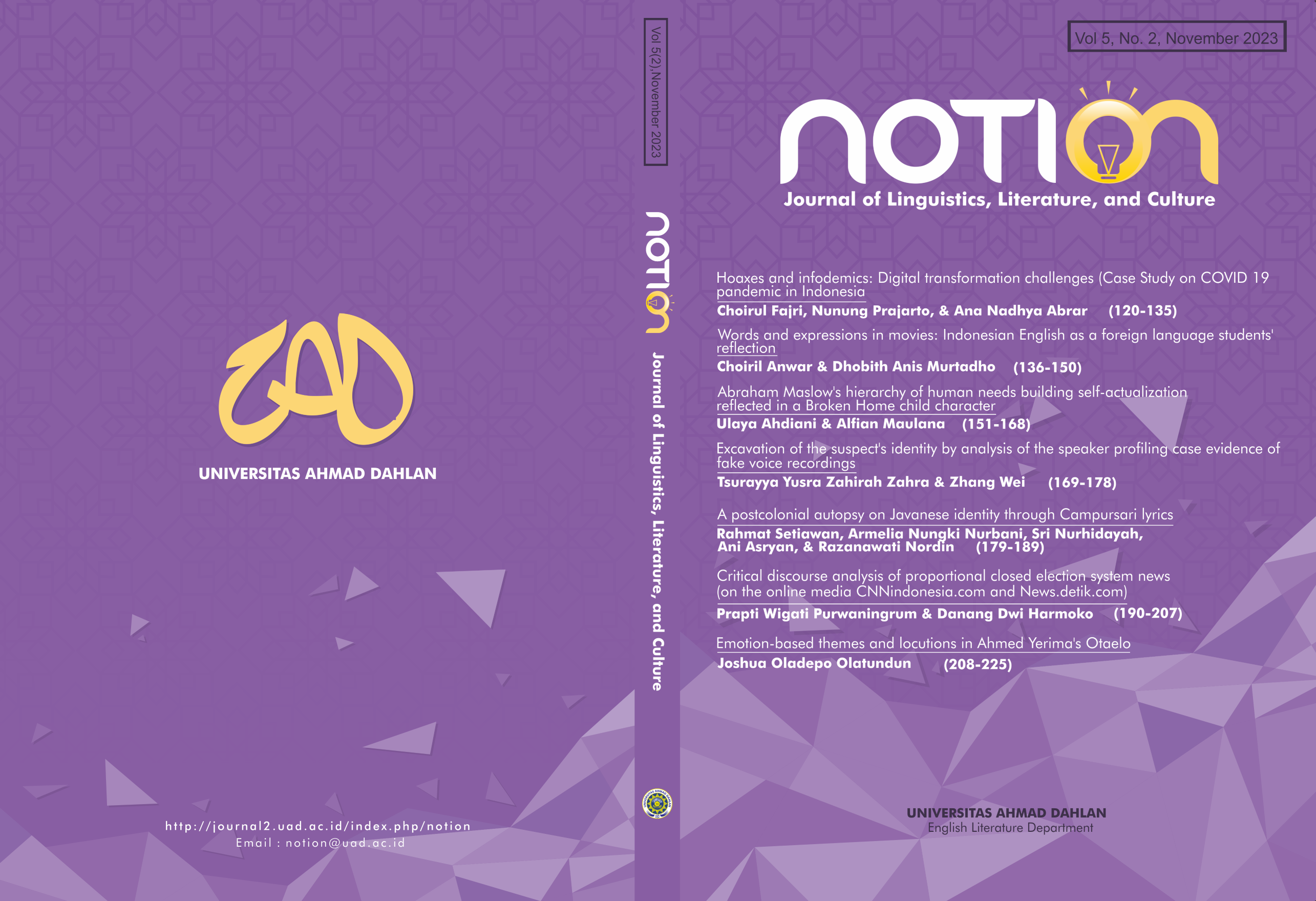Words and expressions in movies: Indonesian English as a foreign language students’ reflection
DOI:
https://doi.org/10.12928/notion.v5i2.7820Keywords:
Discourse , Words , Expression , Thor RagnarokAbstract
This study was aimed to find out the students’ reflection on the words and expressions found in English-spoken Hollywood movies, more particularly Thor Ragnarok. This descriptive quantitative study was conducted via discord. The population of the study was SMAN 2 Semarang students and the samples were the eleventh-grade students who watch Thor Ragnarok movie. The data were collected through questionnaire. The result of analysis showed that there are many students who feel their English are improved by watching Hollywood movies but they also absorb the culture like kinds of impolite words and expressions. After all, the results can give implication for how students need to study on absorbing western cultures correctly and using the words and expressions properly in appropriate ways.
References
Al Murshidi, G. (2020). Effectiveness of movies in teaching and learning English as a foreign language at universities in UAE. Psychology and Education, 57(6), 442-450. http://www.psychologyandeducation.net/pae/index.php/pae/article/view/50
Altun, M., & Hussein, K. O. (2022). The impact of watching movies on students’ speaking ability. Canadian Journal of Language and Literature Studies, 2(5), 14-31. https://doi.org/10.53103/cjlls.v2i5.52
Arikunto, S. (2006). Prosedur penelitian tindakan kelas. Bumi Aksara
Cohen, L., Manion, L., & Morrison, K. (2007). Research methods in education, 6. Routledge.
Elgana, A. A. (2012). The impact of reflection on work behavior. Kuwait chapter of. Arabian Journal of Business and Management Review, 2(2), 56-71. https://platform.almanhal.com/Files/Articles/38153
Ferreira, L. H. F. (2007). How to teach vocabulary effectively: An analysis of the course book Eyes and Spies (Bachelor's thesis).
Habibiloyevna, M. D. (2021). The Semantic Analysis of Slang in The Movie “School”. Journal of Pedagogical Inventions and Practices, 3, 83-85. https://zienjournals.com/index.php/jpip/article/view/432
Hardini, S., & Sitohang, R. (2019). The use of language as a socialcultural communication. Jurnal littera: Fakultas sastra darma agung, 1(2), 238-249. http://jurnal.darmaagung.ac.id/index.php/littera/article/view/331
Hashemian, M., & Arezi, A. (2017). A study of applied strategies in translating idiomatic expressions in two movie subtitles: Bring it on & Mean Girls. Research in English Language Pedagogy, 3(2), 80-93. https://relp.isfahan.iau.ir/article_533633.html
Hayati, A., & Mohmedi, F. (2011). The effect of films with and without subtitles on listening comprehension of EFL learners. British Journal of Educational Technology, 42(1), 181-192. https://doi.org/10.1111/j.1467-8535.2009.01004.x
Hury. (2015). The impact of western movie towards students’ attitudes. Hermes.
Iranmanesh, A., & Darani, L. H. (2018). Effects of movies and gender on learning English idiomatic and everyday expressions among Iranian EFL learners. MOJES: Malaysian Online Journal of Educational Sciences, 6(3), 1-11. https://mojes.um.edu.my/index.php/MOJES/article/view/12215
Jackson, C. W., Schatschneider, C., & Leacox, L. (2014). Longitudinal analysis of receptive vocabulary growth in young Spanish English–speaking children from migrant families. Language, Speech, and Hearing Services in Schools, 45(1), 40-51. https://doi.org/10.1044/2013_LSHSS-12-0104
Kartomihardjo, S. (1988). Bahasa Cermin Kehidupan Masyarakat (Vol. 1). P2LPTK, Dirjen Dikti, Depdikbud.
Liando, N. V., Sahetapy, R. J., & Maru, M. G. (2018). English major students’perceptions towards watching English movies in listening and speaking skills development. Advances in Social Sciences Research Journal, 5(6). http://doi.org/10.14738/assrj.56.4627
Luo, L., Luk, G., & Bialystok, E. (2010). Effect of language proficiency and executive control on verbal fluency performance in bilinguals. Cognition, 114(1), 29-41. https://doi.org/10.1016/j.cognition.2009.08.014
Melviza, Z., Ys, S. B., & Erdiana, N. (2017). Students’ reflection toward English club activities. Research in English and Education Journal, 2(2), 101-109. https://jim.usk.ac.id/READ/article/view/5771
Merriam-Webster’s Collegiate Dictionary (10th ed.). (1993). Merriam-Webster.
Nath, P. R., Mohamad, M., & Yamat, H. (2017). The effects of movies on the affective filter and English acquisition of low-achieving English learners. Creative Education, 8(08), 1357. https://doi.org/10.4236/ce.2017.88096
Simon, M.K., & White, J. (2013). Validity and reliability in qualitative study. Survey/Interview Validation Rubric for Expert Panel-VREP. https://dissertationrecipes.com/wp-content/uploads/2011/04/Expert-Validation-v3.pdf
Suroko, A. P., & Muktiyo, W. (2018). Film as a Communication Strategy in the Learning Process of Children Character Strengthening in the Digital Era. The 2nd International Conference on Child-Friendly Education (ICCE) 2018. http://hdl.handle.net/11617/10046
Thor: Ragnarok (2023, June 21). in Wikipedia. https://en.wikipedia.org/wiki/Thor:_Ragnarok
Urdan, T. C. (2022). Statistics in plain English: 5th Edition. Routledge.
Downloads
Published
Issue
Section
License
Copyright (c) 2023 Choiril Anwar, Dhobith Anis Murtadho

This work is licensed under a Creative Commons Attribution 4.0 International License.
Authors who publish their articles in NOTION: journal of Linguistics, Literature, and Culture agree to the following terms:
- Authors retain the copyright and grant the journal right of first publication with the work simultaneously licensed under a Creative Commons Attribution 4.0 International License that allows others to share the work with an acknowledgement of the work's authorship and initial publication in this journal.
- Authors are able to enter into separate, additional contractual arrangements for the non-exclusive distribution of the journal's published version of the work (e.g., post it to an institutional repository or publish it in a book), with an acknowledgement of its initial publication in this journal.
- Authors are permitted and encouraged to post their work online (e.g., in institutional repositories or on their website) prior to and during the submission process, as it can lead to productive exchanges, as well as earlier and greater citation of published work.





